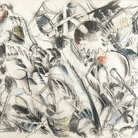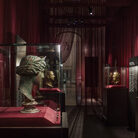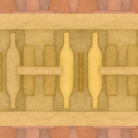Hiroshi Sugimoto. Viaggio in Italia

Hiroshi Sugimoto - Teatro all’Antica, Sabbioneta 2015, gelatin-silver print, 85,5 x 72 x 3 cm. (framed)
Dal 24 November 2023 al 13 February 2024
Roma
Luogo: Galleria Continua - The St. Regis Rome
Indirizzo: Via Vittorio Emanuele Orlando 3
Orari: Martedì - Sabato 11.00 - 19.00
Telefono per informazioni: +39 3333870553
E-Mail info: roma@galleriacontinua.com
Sito ufficiale: http://www.galleriacontinua.com
Galleria Continua è lieta di presentare per la prima volta nei suoi spazi espositivi di Roma, all’interno del prestigioso albergo The St. Regis Rome, una delle figure centrali del panorama artistico internazionale, Hiroshi Sugimoto. “Viaggio in Italia” - questo è il titolo della mostra accompagnata da un testo critico di Ilaria Bernardi - muove dagli interni di alcuni teatri storici (tra questi Bologna, Sabbioneta, Mantova); ripercorre parte delle tappe italiane di un celebre viaggio, di quattro delegati giapponesi conosciuti anche come i “Quattro Ragazzi” o “Tenshō ken’ō shisetsu” che letteralmente significa “L’Ambasciata Tenshō in Europa”; per concludersi negli spazi sconfinati del mare di Amalfi.
“Theaters” è un progetto nato nel 1976 che ha portato l’artista, per più di quarant’anni, a fotografare l’interno di cinema e di teatri di tutto il mondo. Nel 2013, dopo un’interruzione di quasi quindici anni, Sugimoto riprende a lavorare sui teatri includendo per la prima volta nei suoi scatti, oltre allo schermo illuminato, anche la platea e la galleria del teatro, estendendo la visuale allo spazio del pubblico. Nel solco di questa più recente ricerca s’includono le opere esposte in galleria. In “Theaters” il tempo di esposizione utilizzato per lafotografia corrisponde al tempo di proiezione del film, ciò consente a Sugimoto di catturare la durata dell’intero film in un solo scatto, trasformando lo schermo in un rettangolo bianco in grado di illuminare il teatro e restituirne la bellezza architettonica, così come a svelarne i dettagli appena percepibili nella semioscurità. Proprio come avviene nei suoi “Seascapes”, dove i mari rappresentano un passato che va rigenerandosi e ripetendosi - ogni volta più ricco di vissuto e di storia - anche in questa occasione l’artista delega allo spettatore la responsabilità di declinare al tempo attuale la memoria contenuta in un magico spazio bianco.
La serie “Seascapes” presenta vedute del mare, in cui la linea dell’orizzonte, collocata sempre alla stessa altezza, divide equamente acqua e cielo. Prive di qualsiasi presenza umana, imbarcazione, o qualsivoglia altro elemento all’infuori dell’acqua e dell’aria, queste opere ci portano indietro nel tempo donandoci un senso di eternità. Il fotogramma, scattato con una fotocamera di grande formato stile XIX secolo utilizzando pellicola in bianco e nero, cattura il fluire del tempo restituendoci immagini cariche di mistero fatte per essere ammirate e contemplate. “(...) Mistero dei misteri, l’acqua e l’aria sono proprio lì davanti a noi nel mare. Ogni volta che guardo il mare, provo un calmante senso di sicurezza, come se visitassi la mia casa ancestrale; mi imbarco in un viaggio di osservazione” dichiara Hiroshi Sugimoto.
Nell’estate del 2015 l’artista è in Italia per portare avanti il suo progetto sui teatri. Visitando il più antico teatro dell’opera sopravvissuto in Europa, il Teatro Olimpico di Vicenza progettato da Andrea Palladio, s’imbatte per la prima volta nei “quattro ragazzi”. Così Sugimoto racconta la genesi del progetto. “(...) Indicandomi uno dei riquadri dell’affresco (il foyer ha un bellissimo affresco che corre lungo le pareti appena sotto il soffitto n.d.r.), il direttore del teatro mi spiegò che mostrava un gruppo di inviati dal Giappone accolti nel teatro quando visitarono Vicenza di passaggio da Roma nel 1585, anno di apertura del teatro. Dopo un’attenta osservazione potei distinguere, con quasi assoluta certezza, quattro persone dall’aspetto giapponese in prima fila. Erano i famosi giovani delegati, i quattro ragazzi, della missione Tenshō in Europa. Immediatamente nacque in me un forte interesse nel tracciare i viaggi dei quattro ragazzi in giro per l’Italia. Cominciai a indagare sui loro spostamenti e scoprii che dopo essere sbarcati a Livorno si erano recati a Pisa e a Firenze, via Siena a Roma, e poi da Assisi a Venezia. Avevo fotografato il Pantheon di Roma, la Torre Pendente di Pisa e il Duomo di Siena, tutti edifici che c’erano già quando i quattro ragazzi sono arrivati in Italia. Quasi per caso, mi resi conto che stavo vedendo gli stessi edifici che avevano visto i quattro ragazzi. Mi raggiunsero voci da un tempo lontano: ‘vogliamo vedere attraverso i tuoi occhi gli stessi luoghi che una volta vedemmo in Europa’, dicevano. Le voci potevano provenire dal regno dei morti piuttosto che da qualche angolo della mia mente, si mescolavano, risuonavano, si facevano udire solo da me come un’eco. Avendo fino a quel momento seguito solo per caso le orme dei quattro ragazzi, decisi consapevolmente di visitare e fotografare altri luoghi che avevano visitato. Il caso si era trasformato in necessità. Non avevo idea di quanto fedelmente avrei potuto ricreare, 400 anni dopo, il modo in cui le cose apparivano in quei tempi. (...) Ho visitato i luoghi di origine del mio spirito e ho fatto un viaggio allo scopo di avere una conferma visiva, che svelo qui in questa mostra”.
Come si legge nel testo di Ilaria Bernardi “l’idea di fondo degli scatti esposti a Galleria Continua / Roma, St. Regis Rome che fanno parte di quel progetto è vincere contro il tempo, annullandone lo scorrimento, eternizzandolo e cristallizzandolo in uno specifico momento”.
Hiroshi Sugimoto nasce a Tokyo nel 1948. Nel 1970 si laurea alla Saint Paul’s University di Tokyo e successivamente nel 1974, all’Art Center College of Design di Los Angeles. In quello stesso anno si trasferisce a New York, attualmente vive e lavora tra Tokyo e New York. . Figura poliedrica, ha sviluppato la sua pratica artistica principalmente attraverso lafotografia, associata talvolta a oggetti scultorei, architetture e allestimenti espositivi sperimentali. Raggruppate in cicli tematici che si sviluppano nel lungo periodo, le fotografie di Hiroshi Sugimoto, sono uno strumento di indagine sullo stesso mezzo fotografico, attraverso il quale nascondere o svelare la sottile linea che separa la realtà dall’apparenza. La sua ricerca si presenta come una riflessione sul tempo, che passa sia per la procedura di lavoro, sia per la scelta dei soggetti, cristallizzati in un attimo e resi eterni dallo scatto dell’artista con un’intuizione quasi visionaria.
Sugimoto ha esposto nei musei di tutto il mondo, le sue opere sono ospitate in prestigiose collezioni: Metropolitan Museum of Art, New York; Moderna Museet, Stoccolma; Centre Georges Pompidou, Parigi; Museum of Contemporary Art, Tokyo; Museum of Modern Art, New York; National Gallery, Londra; National Museum of Modern Art, Tokyo; Smithsonian Institution, Washington, D.C.; MACBA, Barcellona; Tate Gallery, Londra. Tra le maggiori personali ricordiamo quelle organizzate presso il Himeji City Museum of Art, Himeji (2022), le Château de Versailles (2019), il Kyoto City KYOCERA Museum of Art, Kyoto (2020), il Kyoto City KYOCERA Museum of Art, Kyoto (2020), il Royal Museum of Fine Arts of Belgium a Brusselles (2018), la Fondazione Sandretto Re Rebaudengo di Torino (2017), il Multimedia Art Museum di Mosca (2016), la Fondazione Fotografia di Modena (2015), il Palais de Tokyo di Parigi (2014), il Solomon R. Guggenheim Museum di New York (2013), l’Hara Museum of Contemporary Art di Tokyo (2012), la Scottish National Gallery of Modern Art di Edinburgo (2011), la Neue Nationalgalerie di Berlino (2008), il de Young Museum di San Francisco (2007), l’Hirshhorn Museum di Washington D.C. (2006), il Mori Art Museum di Tokyo (2005), la Fondation Cartier pour l’Art Contemporain di Parigi (2004), il Guggenheim Museum di Bilbao / Deutche Guggenheim di Berlino (2000), il Metropolitan Museum of Art di New York (1995). Nel 1988 ha ricevuto il Mainichi Art Prize, nel 2009 il Praemium Imperiale della Japanese Art Association; nel 2001 il suo lavoro è stato premiato con il prestigioso Hasselblad Foundation International Award, nel 2014 con l’Isamu Noguchi Award, nel 2017 con la Centenary Medal del The Royal Photographic Society, nel 2018 con il National Arts Club Medal of Honor in Photography. Fino al 7 gennaio 2024 l’Hayward Gallery di Londra ospiterà “Time machine”, un’ampia mostra personale dell’artista. Nel 2024, la mostra viaggerà poi all’UCCA Center for Contemporary Art, a Pechino e al Museum of Contemporary Art Australia, a Sydney.
Galleria Continua ha sede all’interno del prestigioso hotel The St. Regis Rome, con il quale dal 2018 ha presentato lavori di artisti internazionali del calibro di Loris Cecchini, Pascale Marthine Tayou, Sun Yuan & Peng Yu, Hans Op De Beeck,Ai Weiwei, per citarne alcuni. Insieme collaborano anche con Città dell’Arte Fondazione Pistoletto con la quale spesso ospitano workshops e talks per bambini in età scolare. Dal 2022 Galleria Continua è parte attiva di Arte di Vivere il festival dedicato a arte, musica e cucina per la città di Roma organizzato dal St. Regis Rome. In concomitanza con l’inaugurazione della mostra di Michelangelo Pistoletto l’albergo presenterà la stagione del Garden e le novità del The St. Regis.
“Theaters” è un progetto nato nel 1976 che ha portato l’artista, per più di quarant’anni, a fotografare l’interno di cinema e di teatri di tutto il mondo. Nel 2013, dopo un’interruzione di quasi quindici anni, Sugimoto riprende a lavorare sui teatri includendo per la prima volta nei suoi scatti, oltre allo schermo illuminato, anche la platea e la galleria del teatro, estendendo la visuale allo spazio del pubblico. Nel solco di questa più recente ricerca s’includono le opere esposte in galleria. In “Theaters” il tempo di esposizione utilizzato per lafotografia corrisponde al tempo di proiezione del film, ciò consente a Sugimoto di catturare la durata dell’intero film in un solo scatto, trasformando lo schermo in un rettangolo bianco in grado di illuminare il teatro e restituirne la bellezza architettonica, così come a svelarne i dettagli appena percepibili nella semioscurità. Proprio come avviene nei suoi “Seascapes”, dove i mari rappresentano un passato che va rigenerandosi e ripetendosi - ogni volta più ricco di vissuto e di storia - anche in questa occasione l’artista delega allo spettatore la responsabilità di declinare al tempo attuale la memoria contenuta in un magico spazio bianco.
La serie “Seascapes” presenta vedute del mare, in cui la linea dell’orizzonte, collocata sempre alla stessa altezza, divide equamente acqua e cielo. Prive di qualsiasi presenza umana, imbarcazione, o qualsivoglia altro elemento all’infuori dell’acqua e dell’aria, queste opere ci portano indietro nel tempo donandoci un senso di eternità. Il fotogramma, scattato con una fotocamera di grande formato stile XIX secolo utilizzando pellicola in bianco e nero, cattura il fluire del tempo restituendoci immagini cariche di mistero fatte per essere ammirate e contemplate. “(...) Mistero dei misteri, l’acqua e l’aria sono proprio lì davanti a noi nel mare. Ogni volta che guardo il mare, provo un calmante senso di sicurezza, come se visitassi la mia casa ancestrale; mi imbarco in un viaggio di osservazione” dichiara Hiroshi Sugimoto.
Nell’estate del 2015 l’artista è in Italia per portare avanti il suo progetto sui teatri. Visitando il più antico teatro dell’opera sopravvissuto in Europa, il Teatro Olimpico di Vicenza progettato da Andrea Palladio, s’imbatte per la prima volta nei “quattro ragazzi”. Così Sugimoto racconta la genesi del progetto. “(...) Indicandomi uno dei riquadri dell’affresco (il foyer ha un bellissimo affresco che corre lungo le pareti appena sotto il soffitto n.d.r.), il direttore del teatro mi spiegò che mostrava un gruppo di inviati dal Giappone accolti nel teatro quando visitarono Vicenza di passaggio da Roma nel 1585, anno di apertura del teatro. Dopo un’attenta osservazione potei distinguere, con quasi assoluta certezza, quattro persone dall’aspetto giapponese in prima fila. Erano i famosi giovani delegati, i quattro ragazzi, della missione Tenshō in Europa. Immediatamente nacque in me un forte interesse nel tracciare i viaggi dei quattro ragazzi in giro per l’Italia. Cominciai a indagare sui loro spostamenti e scoprii che dopo essere sbarcati a Livorno si erano recati a Pisa e a Firenze, via Siena a Roma, e poi da Assisi a Venezia. Avevo fotografato il Pantheon di Roma, la Torre Pendente di Pisa e il Duomo di Siena, tutti edifici che c’erano già quando i quattro ragazzi sono arrivati in Italia. Quasi per caso, mi resi conto che stavo vedendo gli stessi edifici che avevano visto i quattro ragazzi. Mi raggiunsero voci da un tempo lontano: ‘vogliamo vedere attraverso i tuoi occhi gli stessi luoghi che una volta vedemmo in Europa’, dicevano. Le voci potevano provenire dal regno dei morti piuttosto che da qualche angolo della mia mente, si mescolavano, risuonavano, si facevano udire solo da me come un’eco. Avendo fino a quel momento seguito solo per caso le orme dei quattro ragazzi, decisi consapevolmente di visitare e fotografare altri luoghi che avevano visitato. Il caso si era trasformato in necessità. Non avevo idea di quanto fedelmente avrei potuto ricreare, 400 anni dopo, il modo in cui le cose apparivano in quei tempi. (...) Ho visitato i luoghi di origine del mio spirito e ho fatto un viaggio allo scopo di avere una conferma visiva, che svelo qui in questa mostra”.
Come si legge nel testo di Ilaria Bernardi “l’idea di fondo degli scatti esposti a Galleria Continua / Roma, St. Regis Rome che fanno parte di quel progetto è vincere contro il tempo, annullandone lo scorrimento, eternizzandolo e cristallizzandolo in uno specifico momento”.
Hiroshi Sugimoto nasce a Tokyo nel 1948. Nel 1970 si laurea alla Saint Paul’s University di Tokyo e successivamente nel 1974, all’Art Center College of Design di Los Angeles. In quello stesso anno si trasferisce a New York, attualmente vive e lavora tra Tokyo e New York. . Figura poliedrica, ha sviluppato la sua pratica artistica principalmente attraverso lafotografia, associata talvolta a oggetti scultorei, architetture e allestimenti espositivi sperimentali. Raggruppate in cicli tematici che si sviluppano nel lungo periodo, le fotografie di Hiroshi Sugimoto, sono uno strumento di indagine sullo stesso mezzo fotografico, attraverso il quale nascondere o svelare la sottile linea che separa la realtà dall’apparenza. La sua ricerca si presenta come una riflessione sul tempo, che passa sia per la procedura di lavoro, sia per la scelta dei soggetti, cristallizzati in un attimo e resi eterni dallo scatto dell’artista con un’intuizione quasi visionaria.
Sugimoto ha esposto nei musei di tutto il mondo, le sue opere sono ospitate in prestigiose collezioni: Metropolitan Museum of Art, New York; Moderna Museet, Stoccolma; Centre Georges Pompidou, Parigi; Museum of Contemporary Art, Tokyo; Museum of Modern Art, New York; National Gallery, Londra; National Museum of Modern Art, Tokyo; Smithsonian Institution, Washington, D.C.; MACBA, Barcellona; Tate Gallery, Londra. Tra le maggiori personali ricordiamo quelle organizzate presso il Himeji City Museum of Art, Himeji (2022), le Château de Versailles (2019), il Kyoto City KYOCERA Museum of Art, Kyoto (2020), il Kyoto City KYOCERA Museum of Art, Kyoto (2020), il Royal Museum of Fine Arts of Belgium a Brusselles (2018), la Fondazione Sandretto Re Rebaudengo di Torino (2017), il Multimedia Art Museum di Mosca (2016), la Fondazione Fotografia di Modena (2015), il Palais de Tokyo di Parigi (2014), il Solomon R. Guggenheim Museum di New York (2013), l’Hara Museum of Contemporary Art di Tokyo (2012), la Scottish National Gallery of Modern Art di Edinburgo (2011), la Neue Nationalgalerie di Berlino (2008), il de Young Museum di San Francisco (2007), l’Hirshhorn Museum di Washington D.C. (2006), il Mori Art Museum di Tokyo (2005), la Fondation Cartier pour l’Art Contemporain di Parigi (2004), il Guggenheim Museum di Bilbao / Deutche Guggenheim di Berlino (2000), il Metropolitan Museum of Art di New York (1995). Nel 1988 ha ricevuto il Mainichi Art Prize, nel 2009 il Praemium Imperiale della Japanese Art Association; nel 2001 il suo lavoro è stato premiato con il prestigioso Hasselblad Foundation International Award, nel 2014 con l’Isamu Noguchi Award, nel 2017 con la Centenary Medal del The Royal Photographic Society, nel 2018 con il National Arts Club Medal of Honor in Photography. Fino al 7 gennaio 2024 l’Hayward Gallery di Londra ospiterà “Time machine”, un’ampia mostra personale dell’artista. Nel 2024, la mostra viaggerà poi all’UCCA Center for Contemporary Art, a Pechino e al Museum of Contemporary Art Australia, a Sydney.
Galleria Continua ha sede all’interno del prestigioso hotel The St. Regis Rome, con il quale dal 2018 ha presentato lavori di artisti internazionali del calibro di Loris Cecchini, Pascale Marthine Tayou, Sun Yuan & Peng Yu, Hans Op De Beeck,Ai Weiwei, per citarne alcuni. Insieme collaborano anche con Città dell’Arte Fondazione Pistoletto con la quale spesso ospitano workshops e talks per bambini in età scolare. Dal 2022 Galleria Continua è parte attiva di Arte di Vivere il festival dedicato a arte, musica e cucina per la città di Roma organizzato dal St. Regis Rome. In concomitanza con l’inaugurazione della mostra di Michelangelo Pistoletto l’albergo presenterà la stagione del Garden e le novità del The St. Regis.
SCARICA IL COMUNICATO IN PDF
COMMENTI

-
 Dal 20 December 2025 al 20 April 2026
Caserta | Reggia di Caserta
Dal 20 December 2025 al 20 April 2026
Caserta | Reggia di Caserta
Regine: trame di cultura e diplomazia tra Napoli e l’Europa
-
 Dal 19 December 2025 al 23 March 2026
Torino | Palazzo Madama - Museo Civico d’Arte Antica
Dal 19 December 2025 al 23 March 2026
Torino | Palazzo Madama - Museo Civico d’Arte Antica
Il castello ritrovato. Palazzo Madama dall’età romana al medioevo
-
 Dal 17 December 2025 al 19 January 2026
Roma | Palazzo della Cancelleria
Dal 17 December 2025 al 19 January 2026
Roma | Palazzo della Cancelleria
De Humana Mensura di Linda Karshan
-
 Dal 18 December 2025 al 12 April 2026
Firenze | Gallerie degli Uffizi
Dal 18 December 2025 al 12 April 2026
Firenze | Gallerie degli Uffizi
Cera una volta. Sculture dalle collezioni medicee
-
 Dal 11 December 2025 al 9 April 2026
Firenze | Museo Archeologico Nazionale di Firenze
Dal 11 December 2025 al 9 April 2026
Firenze | Museo Archeologico Nazionale di Firenze
Icone di Potere e Bellezza
-
 Dal 11 December 2025 al 11 January 2026
Roma | Palazzo Esposizioni Roma
Dal 11 December 2025 al 11 January 2026
Roma | Palazzo Esposizioni Roma
Giorgio Morandi nella Collezione Eni. Un viaggio attraverso la storia culturale del cane a sei zampe e l’eredità di Enrico Mattei


